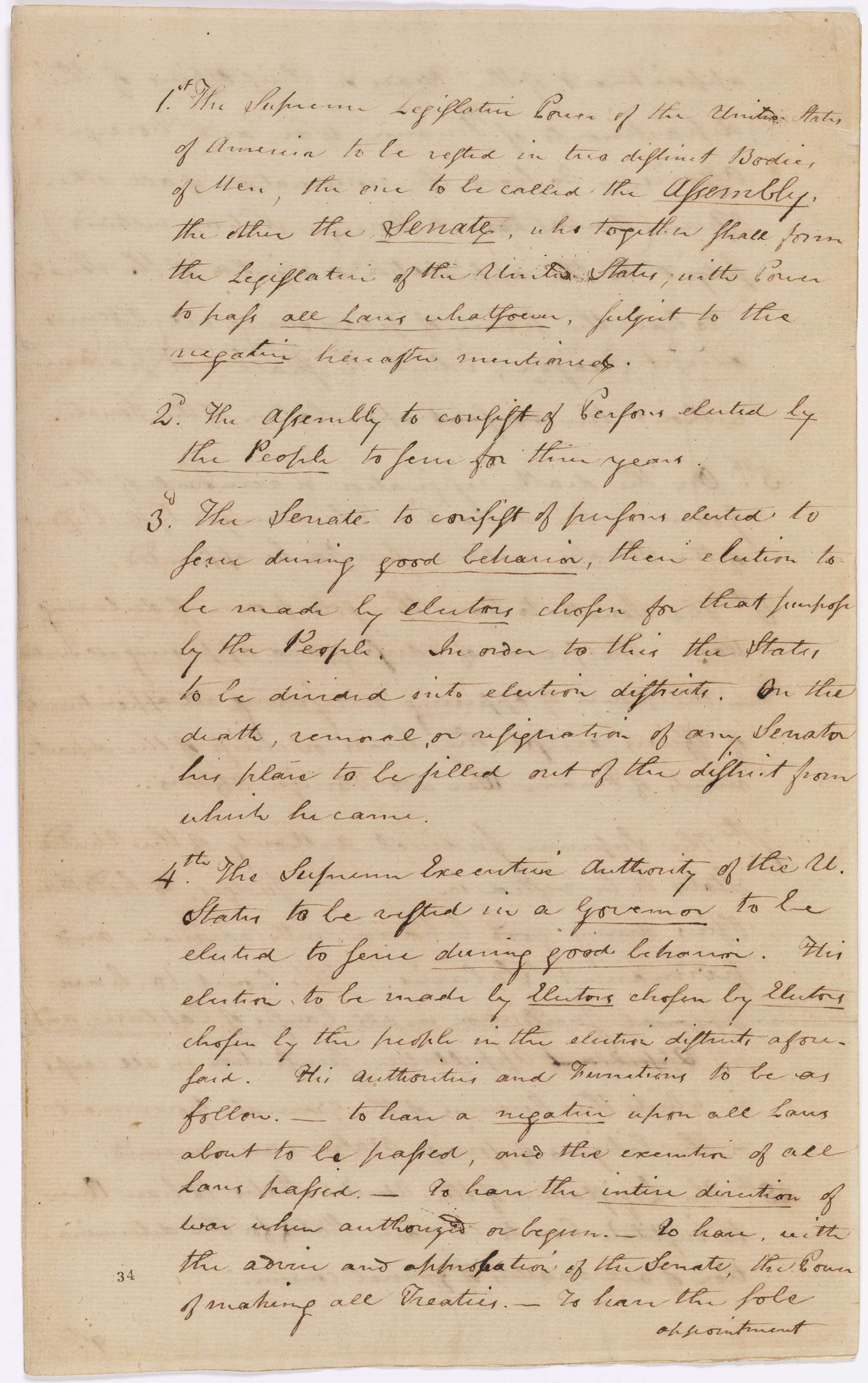Alexander Hamilton’s Plan of Government
6/18/1787
Add to Favorites:
Add all page(s) of this document to activity:

Add only page 1 to activity:
Add only page 2 to activity:
Add only page 3 to activity:
Alexander Hamilton served as a New York delegate at the Constitutional Convention that ultimately framed a new national system of government embodied in the United States Constitution. On June 18, 1787, Hamilton famously spoke for six hours straight while he proposed his own "Plan of Government" to the Convention. His 11-point plan called for a strong centralized government that concentrated power with the "Supreme Executive" (President) and lifetime terms for the Executive and Senators after their election. Although Hamilton’s plan was never seriously considered, he campaigned passionately for the new Constitution’s ratification.
Transcript
1st The Supreme Legislative Power of the United States of America to be vested in two distinct Bodies of Men-- the one to be called the Assembly the other the Senate, who together shall form the Legislature of the United States, with the Power to pass all laws whatsoever, subject to the negative hereafter mentioned.2nd The Assembly to consist of persons elected by the People to serve for three years.
3rd The Senate to consist of persons elected to serve during good behaviour, their election to be made by electors chosen for that purpose by the People. In order to this the States to be divided into election districs. On the death, removal, or resignation of any Senator his place to be filled out of the district from which he came.
4th The Supreme Executive authority of the United States to be vested in a governor to be elected to serve during good behaviour. His election to be made by Electors chosen by Electors chosen by the people in the election districts aforesaid. His authorities and functions to be as follow. --- to have a negative upon all Laws about to be passed, and the execution of all Laws passed.--- To have the entire direction of war when the authorised or began.-- To have, with the advice and approbation of the Senate, the Power of making all Treaties. --- To have the sole
appointment
appointment of the Heads or Chief Officers of the departments of Finance, War and Foreign Affairs.— To have the nomination of all other officers (Ambassadors to Foreign Nations included) subject to the approbation or rejection of the Senate. To have the power of pardoning all offences except Treason, which he shall not pardon without the approbation of the Senate.
5th On the death, resignation or removal of the governor, his authorities to be exercised by the President of the Senate until a successor be appointed.
6th The Senate to have the sole power of declaring war: the power of advising and approving all Treaties—the power of approving or rejecting all appointments of officers, except the heads or chiefs of the departments of Finance War and Foreign Affairs.
7th The Supreme Judicial authority of the United States to be vested in Judges, to hold their offices during good behaviour, with adequate and permanent salaries. This Court to have original Jurisdiction in all Causes of Capture, and an Appellative Jurisdiction in all causes in which the Revenues of the general government, or citizens of foreign Nations are concerned.
8th The Legislature of the United States to have Power to institute Courts in each State for the determination of all matters of general concern.
9th
9th The Governors, Senators and all Officers of the United States to be liable to impeachment for Mal and corrupt conduct, and upon Conviction to be removed from office and disqualified for holding any place of trust or profit. All impeachments to be tried by a Court to consist of the Chief or Senior Judge of the Superior Court of Law of each State, provided that such Judge hold his place during good behaviour and have a permanent Salary.
10th All Laws of the particular States, contrary to the Constitution or laws of the United States to be utterly void. And the better to prevent such Laws being passed; the governor or President of each State shall be appointed by the general government and shall have a negative upon the Laws about to be passed in the State of which he is governor or President.
11th No State to have any Forces, Land or Naval, and the Militia of all the States to be under the sole and exclusive direction of the United States, the officers of which to be appointed and commissioned by them.
Col. Hamilton's Plan of a Constitution of government of the States.
1787
B.
This primary source comes from the Records of the Continental and Confederation Congresses and the Constitutional Convention.
National Archives Identifier: 44176956
Full Citation: Alexander Hamilton’s Plan of Government; 6/18/1787; Papers of David Brearley; Official Records of the Constitutional Convention of 1787, 1785 - 1787; Records of the Continental and Confederation Congresses and the Constitutional Convention, Record Group 360; National Archives Building, Washington, DC. [Online Version, https://docsteach.org/documents/document/hamilton-plan-government, April 18, 2024]Rights: Public Domain, Free of Known Copyright Restrictions. Learn more on our privacy and legal page.






